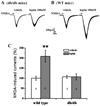Leptin enhances NMDA-induced spinal excitation in rats: A functional link between adipocytokine and neuropathic pain
- PMID: 21376468
- PMCID: PMC3098907
- DOI: 10.1016/j.pain.2011.01.054
Leptin enhances NMDA-induced spinal excitation in rats: A functional link between adipocytokine and neuropathic pain
Abstract
Recent studies have shown that leptin (an adipocytokine) played an important role in nociceptive behavior induced by nerve injury, but the cellular mechanism of this action remains unclear. Using the whole-cell patch-clamp recording from rat's spinal cord slices, we showed that superfusion of leptin onto spinal cord slices dose-dependently enhanced N-methyl-d-aspartate (NMDA) receptor-mediated currents in spinal cord lamina II neurons. At the cellular level, the effect of leptin on spinal NMDA-induced currents was mediated through the leptin receptor and the JAK2/STAT3 (but not PI3K or MAPK) pathway, as the leptin effect was abolished in leptin receptor-deficient (db/db) mice and inhibited by a JAK/STAT inhibitor. Moreover, we demonstrated in naïve rats that a single intrathecal administration of leptin enhanced spontaneous biting, scratching, and licking behavior induced by intrathecal NMDA and that repeated intrathecal administration of leptin elicited thermal hyperalgesia and mechanical allodynia, which was attenuated by the noncompetitive NMDA receptor antagonist MK-801. Intrathecal leptin also upregulated the expression of NMDA receptors and pSTAT3 within the rat's spinal cord dorsal horn, and intrathecal MK-801 attenuated this leptin effect as well. Our data demonstrate a relationship between leptin and NMDA receptor-mediated spinal neuronal excitation and its functional role in nociceptive behavior. Since leptin contributes to nociceptive behavior induced by nerve injury, the present findings suggest an important cellular link between the leptin's spinal effect and the NMDA receptor-mediated cellular mechanism of neuropathic pain. A functional link is demonstrated between leptin, an adipocytokine, and the cellular mechanisms of neuropathic pain via enhancement of function and expression of spinal N-methyl-d-aspartate receptors.
Copyright © 2011 International Association for the Study of Pain. Published by Elsevier B.V. All rights reserved.
Conflict of interest statement
The authors declare no conflict of interest.
Figures







Similar articles
-
Role of the spinal cord NR2B-containing NMDA receptors in the development of neuropathic pain.Exp Neurol. 2009 Feb;215(2):298-307. doi: 10.1016/j.expneurol.2008.10.018. Epub 2008 Nov 12. Exp Neurol. 2009. PMID: 19046970
-
Activation of NMDA receptor is associated with up-regulation of COX-2 expression in the spinal dorsal horn during nociceptive inputs in rats.Neurochem Res. 2009 Aug;34(8):1451-63. doi: 10.1007/s11064-009-9932-9. Epub 2009 Apr 1. Neurochem Res. 2009. PMID: 19337831
-
Potentiation of spinal N-methyl-D-aspartate-mediated nociceptive transmission by cocaine-regulated and amphetamine-regulated transcript peptide in rats.Neuroreport. 2005 Feb 28;16(3):253-7. doi: 10.1097/00001756-200502280-00010. Neuroreport. 2005. PMID: 15706230
-
Spinal D-Serine Increases PKC-Dependent GluN1 Phosphorylation Contributing to the Sigma-1 Receptor-Induced Development of Mechanical Allodynia in a Mouse Model of Neuropathic Pain.J Pain. 2017 Apr;18(4):415-427. doi: 10.1016/j.jpain.2016.12.002. Epub 2016 Dec 14. J Pain. 2017. PMID: 27986591
-
Targeting N-methyl-D-aspartate receptors for treatment of neuropathic pain.Expert Rev Clin Pharmacol. 2011 May;4(3):379-88. doi: 10.1586/ecp.11.17. Expert Rev Clin Pharmacol. 2011. PMID: 21686074 Free PMC article. Review.
Cited by
-
Transcutaneous auricular vagal nerve stimulation releases extrapineal melatonin and reduces thermal hypersensitivity in Zucker diabetic fatty rats.Front Neurosci. 2022 Aug 11;16:916822. doi: 10.3389/fnins.2022.916822. eCollection 2022. Front Neurosci. 2022. PMID: 36033612 Free PMC article.
-
Activated Human Adipose Tissue Transplantation Promotes Sensorimotor Recovery after Acute Spinal Cord Contusion in Rats.Cells. 2024 Jan 17;13(2):182. doi: 10.3390/cells13020182. Cells. 2024. PMID: 38247873 Free PMC article.
-
Smoking is associated with reduced leptin and neuropeptide Y levels and higher pain experience in patients with fibromyalgia.Mediators Inflamm. 2014;2014:627041. doi: 10.1155/2014/627041. Epub 2014 Aug 14. Mediators Inflamm. 2014. PMID: 25197167 Free PMC article.
-
Ectopic endometrium-derived leptin produces estrogen-dependent chronic pain in a rat model of endometriosis.Neuroscience. 2014 Jan 31;258:111-20. doi: 10.1016/j.neuroscience.2013.11.008. Epub 2013 Nov 14. Neuroscience. 2014. PMID: 24239717 Free PMC article.
-
CXCL13 drives spinal astrocyte activation and neuropathic pain via CXCR5.J Clin Invest. 2016 Feb;126(2):745-61. doi: 10.1172/JCI81950. Epub 2016 Jan 11. J Clin Invest. 2016. PMID: 26752644 Free PMC article.
References
-
- Ahima RS, Qi Y, Singhal NS, Jackson MB, Scherer PE. Brain adipocytokine action and metabolic regulation. Diabetes. 2006;55:S145–S154. - PubMed
-
- Banks WA. The many lives of leptin. Peptides. 2004;25:331–338. - PubMed
-
- Bjørbaek C, Kahn BB. Leptin signaling in the central nervous system and the periphery. Recent Prog Horm Res. 2004;59:305–331. - PubMed
-
- Bjorkman R, Hallman KM, Hedner J, Hedner T, Henning M. Acetaminophen blocks spinal hyperalgesia induced by NMDA and substance P. Pain. 1994;57:259–264. - PubMed
-
- Chen H, Charlat O, Tartaglia LA, Woolf EA, Weng X, Ellis SJ, Lakey ND, Culpepper J, Moore KJ, Breitbart RE, Duyk GM, Tepper RI, Morgenstern JP. Evidence that the diabetes gene encodes the leptin receptor: identification of a mutation in the leptin receptor gene in db/db mice. Cell. 1996;84:491–495. - PubMed
Publication types
MeSH terms
Substances
Grants and funding
LinkOut - more resources
Full Text Sources
Miscellaneous

